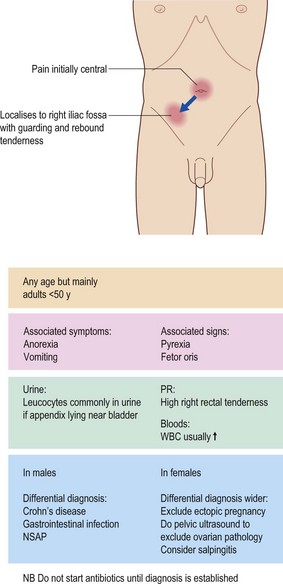5 Common surgical emergencies
Abdominal pain
History
• Onset (especially exactly where the pain started)
• Site, radiation and progression
Examination
Inspection
• Swellings (bulges at site of hernia orifices)
• Scars (beware the scars that are easy to miss, e.g. in the groins, skin creases and loins, laparoscopic scars)
• Discoloration (e.g. bluish colour around umbilicus (Cullen’s sign) or flanks (Grey Turner’s sign) seen in haemorrhagic pancreatitis)
• Visible peristalsis (obstructed bowel)/pulsation (abdominal aortic aneurysm: AAA).
Palpation
• Tenderness (establish area of tenderness and site of maximum severity)
• Guarding (reflex contraction of the abdominal wall in response to palpation)
• Rebound tenderness (exacerbation of pain on sudden release of the palpating hand; care is needed to avoid excessive discomfort)
• Masses (establish site and nature)
• Organs (liver, kidneys and spleen)
• AAA (felt as a pulsatile, expansile swelling in the epigastrium)
• Check the groins carefully. Strangulated femoral hernias are quite often missed, especially in elderly women with non-specific symptoms
Investigation
Urine
• Urinalysis is vital to exclude diabetes, pregnancy and microscopic haematuria
• Any condition causing inflammation in the lower abdomen can cause leucocytes in the urine (e.g. appendicitis and diverticulitis) and this does NOT confirm a urinary tract infection (UTI)
• Bilirubin appears in urine in obstructive jaundice
• Urine microscopy and culture (microscopy may demonstrate numerous organisms in UTI)
Plain X-rays
Box 5.1 The plain AXR in the acute abdomen is full of useful information. It is often helpful to re-examine the abdomen after inspecting the AXR
Gas pattern
CT scanning
When teamed with a good clinical assessment, CT scanning is a tremendously useful examination to diagnose acute abdominal pain. It is sometimes said that a CT scan is unnecessary if there is already an indication for laparotomy. However, CT may render some operations unnecessary (e.g. by confirming terminal malignant disease, or demonstrating acute pancreatitis where perforated duodenal ulceration was expected). Other operations may be made easier by providing useful information preoperatively (Table 5.1). The risk of ionising radiation and contrast exposure must always be weighed against these potential benefits.
| Indication | Advantage of CT |
|---|---|
| Pancreatitis | Demonstrates pancreatic necrosis |
| Aortic aneurysm | CT scanning is the only reliable way to exclude aortic rupture (ultrasound detects aneurysms but does not exclude rupture) |
| Severe or non-resolving diverticulitis | Allows differentiation between localised perforation of diverticulum, diverticular abscess, diverticular mass |
| Large bowel obstruction | Avoids need for water-soluble contrast enema. Usually accurately demonstrates level of obstruction and cause |
| Small bowel obstruction with no hernia or scars | May detect the cause of the obstruction preoperatively |
| Suspicion of malignancy | Acute abdominal pain is common in advanced malignancy. CT scanning may confirm extensive metastatic disease, avoiding laparotomy when palliative care is more appropriate |
| Peritonitis in absence of gas on AXR | CT scanning is very sensitive for small pockets of free gas after perforation of a viscus |
| Acute abdomen | Standard in many hospitals |
Patterns of abdominal pain
Appendicitis
Pain is initially central, then localises to the right iliac fossa with guarding and rebound tenderness (Fig. 5.1).

Figure 5.1 Symptoms, signs and differential diagnosis of appendicitis. NSAP, non-specific abdominal pain.







